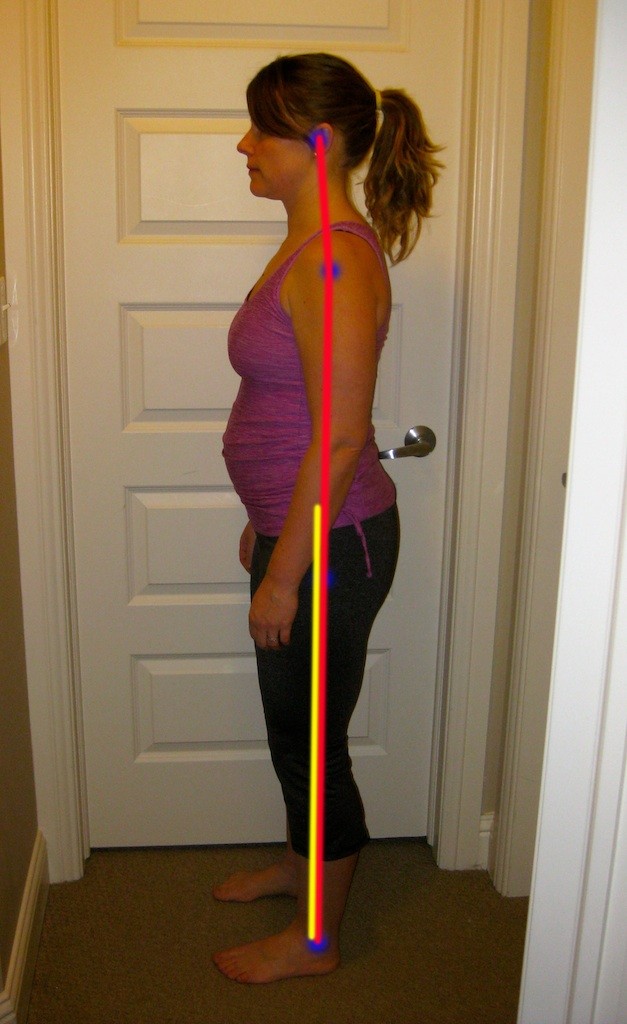Nurture Your Posture Part 2!
Okay, remember that posture plum line we talked about a couple of days ago? (In case you missed it, you can catch up here). Well, its time to look at some subtle nuances in that “line” so you can start to figure out what patterns you might have. I spend all day at the clinic analyzing posture, so I thought it was only fair that you get to analyze mine – and trust me, its far from perfect. 😉
Check out my pictures below – I am standing in three subtly different postures. Think about the 4 landmarks we talked about (ear, shoulder, trochanter of the hip and lateral malleolus of the ankle). How are these pictures different and which do you think is my best posture?
**Note: Don’t let the curve of my belly throw you off – I have a rather large diastasis (abdominal separation) and I am 3 months post partum. Diastasis recti will be a topic for another series of posts! (However, you can bet my habitual posture probably had a role in causing my diastasis…)
A B C
Now take a look ay my little analysis. The red lines are showing you the relationship between the 4 posture landmarks and the yellow line shows where my centre of mass is sitting. (You can click on each picture to see it bigger and the angles are more obvious)
So for those of you who guessed “B” as my best posture – you are correct! It’s not perfect though, so lets break it down:
-Your centre of mass is usually found around the middle of your pelvis. In this picture, my centre of mass is stacked pretty much up over the malleolus/heel (it’s a bit forward, but not too bad). It’s important that your weight is over your heel – that is a big bone designed for weightbearing. You don’t want your weight hanging out over the arch of your foot. The “arch” of your foot (there is actually more than one) is not a bony structure, its held up my muscles and connective tissue. If you constantly carry your weight over the arch, you can stretch it out and force it down (ex. flat feet).
-Of the 4 posture landmarks, 3 are in a nice line! (shoulder, hip, ankle). My head is a bit forward so I need to work on that. A head forward posture is very common in our sedentary, computer-screen-looking population.
-I have a round bum in this picture! That’s important! Ladies, you need to untuck your tails!!! When you tuck your tailbone under, you are taking the pelvis out of its optimal orientation. That puts a lot of excess strain on the pelvic floor muscles. What you are striving for is “neutral” pelvis: the pubic bone and your ASISs (anterior superior iliac spines – those bony bits of your “hips” that stick out) in the same plane. What does that mean? You put one hand on your pubic bone and one hand on those bony things in the front of the pelvis. Are they stacked on top of each other vertically? (Don’t be deceived by my picture, clothing can make it look weird. You have to feel the bones!)
* Caution – don’t stick your tailbone too far out either (I might be a tad out in this picture). You want neutral.
So, moral of the story – B is my best, but its not perfect. So what about the other two postures?
Picture A (Hanging Out):
This is probably the most common posture I see in younger women – I call it “Hanging Out”. Why do I call it that? Because it’s a passive posture where you are allowing your weight to come forward, “hanging” on your pelvic ligaments instead of using your muscles. The “Out” comes from the idea that your weight is out too far forward over your foot, and not stacked over you heel. You are straining a lot of structures in the foot, pelvis, etc. Yikes! But we do it because this posture is easy! It requires minimal effort from our muscles. And look at how my bum is flat and my tailbone is tucked under. Double yikes! Unfortunately, this is my habitual posture. Is it yours? If it is, we have some work to do.
Picture C (High Beams):
Some of you might have been fooled into thinking this was my best posture. It’s not! Why? Because of what I am doing with my rib cage. I am thrusting it forward and up – I call this the High Beams posture because it looks like I am shining my headlights extra bright if you catch my meaning. 😉 This thrusting is not good for the spine because it can create shear. In my body I might feel like I am doing the right thing by trying to pull my shoulders back (gotta stack of those 4 posture landmarks!)… but here’s the curveball – it doesn’t just matter where those points are, it also matters how you get them there! Oh ya, my bum is flat again. 🙁
Now, don’t be too upset if your posture is not perfect! We can work on it – and we absolutely should. Keep your eye out for future posts on posture for tips on how to do that. In the mean time, have someone take a picture of you this weekend, from the side, so you can see where you plum line falls! Don’t be afraid to get a ruler out and actually draw your lines! Good luck!






Yeah, I’m at posture A with you….shudder! Thanks for getting my neurons popping this morning Mandy!